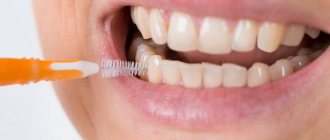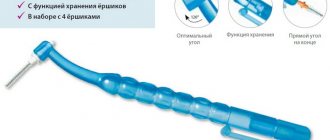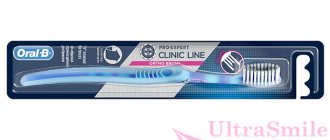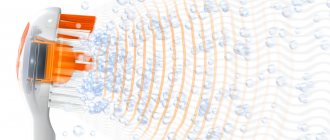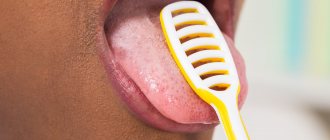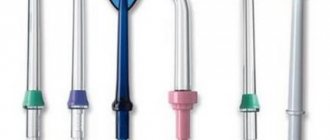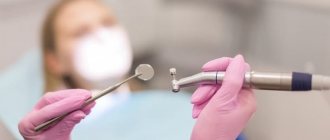Content:
- How they work
- Who needs a teeth brush?
- Classification
- What to look for when choosing
- How to use it correctly
- Yorshik is a friend of braces
Recently, dental brushes have become increasingly popular. These are special dental devices designed for the highest quality cleaning of interdental spaces. Outwardly, they are similar to standard household brushes, but they are hundreds of times smaller.
Terms of use
How to brush your teeth with a brush? They are very easy to use. The bristly rod is at an angle to the holder, making the brush very convenient. But you need to choose the size and shape individually. If it is difficult to decide which option is suitable, you can consult a dentist. The doctor measures and evaluates the anatomical structure of the teeth, after which he will choose the best model.
For cleaning to be effective, you need to choose the right angle of inclination. Dentists recommend holding the brush perpendicular to the teeth. Then you need to carefully insert it into the interdental spaces and make sure that the tip comes out on the other side of the teeth. All that remains is to perform rotational movements and move it back and forth. Then you need to take it out and rinse it under water. In this way, the interdental space of the lower and upper jaw is cleaned.
The toothbrush is used without toothpaste. It is not advisable to use force during insertion of the device, as this can damage the tooth enamel. If the product penetrates into the space between the teeth with difficulty, then a smaller diameter is required. Although the brush looks like new in appearance, it still needs to be changed weekly.
How they work
Brushes for teeth are formed by two components:
- holder;
- cleaning surface with small artificial hairs.
You can find different types of them on sale. The products differ from each other in:
- rigidity;
- quality of lint;
- method of fastening the cleaning surface;
- size of the working surface.
If the dental brush is of high quality, it will not damage mucous membranes or scratch soft tissues. After using it, your gums will not begin to bleed (however, a lot depends on the correct use of the dental accessory).
Contraindications
There are practically no restrictions on use. The device is successfully used by adults and children. The sooner a child learns what a dental brush is, the lower the risk of accumulation of all types of plaque.
Note! Even periodontitis is not an obstacle to using a cylindrical “mini-brush”. When gums are bleeding, a product with softer nylon bristles becomes a salvation for the patient. A regular brush causes severe pain and increases bleeding. The brush delicately but efficiently cleans dental tissue and does not scratch inflamed gums.
Read more about periodontitis here; about bleeding gums is written here; about the treatment of gum inflammation is written in this article.
Who needs a teeth brush?
The product improves oral hygiene and is therefore useful to absolutely anyone. It is especially important for people to use it:
- who have braces installed;
- wearing leveling plates;
- prone to rapid formation of plaque and tartar;
- with large interdental spaces;
- with malocclusions that do not allow proper oral hygiene;
- those suffering from frequent gum disease;
- with crowded teeth;
- with hard-to-reach indigenous units;
- accustomed to drinking coffee;
- addicted to tobacco.
If a person buys a dental brush, he will not go wrong. This device will immediately become his favorite assistant. Be sure to try it!
How to brush teeth with braces?
Brushing your teeth is a must if you wear braces. The procedure takes 10 minutes or more - it all depends on how easily you can use a special orthodontic toothbrush for braces . General recommendations for daily cleaning:
- Remove all removable elements of the bracket system and thoroughly clean them using water and special products.
- Rinse your mouth with water to remove all small food particles.
- Clean your teeth using horizontal and vertical movements. The locks of brace systems are cleaned only vertically.
- Finish the procedure using specialized brushes, cleaning the interdental space.
- Rinse your mouth with mouthwash and return all elements of the orthodontic frame to their place.
If you wear a bite correction system for more than six months (and this almost always happens), you must also undergo a special procedure in the clinic. Professional cleaning is required every six months. It allows you to remove plaque and other contaminants that are very difficult to remove on your own. This procedure also reduces the risk of inflammation on the gums or palate.
Classification
Conventionally, all existing dental brushes can be divided into three large groups:
- Cylindrical. Along the entire perimeter of the working part there are fibers of the same length. They are optimal for caring for large spaces between teeth and gums. Allows high-quality processing of the necks of units covered with crowns.
- Cone-shaped. The bristles on such devices are arranged in the shape of a cone. The long ones are at the base, the short ones (about one millimeter) are at the top. Cone-shaped brushes should be used to remove plaque from narrow interdental areas. They are an excellent alternative to floss.
- Curved. Made in the form of a semi-oval. Designed for the care of braces and plates. Due to the unusual shape, they easily pass between the fastenings of the orthodontic apparatus and quickly sweep out all food “deposits” from the lock.
In pharmacies you can find brushes with forked bristles at the tips. They are more effective than classic ones. This should be kept in mind when making a purchase.
Kinds
Let's look at the main types of brushes:
- Cylindrical. The same length of bristles on the brush helps to evenly clean the space between the teeth. Especially if it is wide. The form is also recommended for caring for the root necks of implants, in order to prevent periodontal disease. Cylindrical brushes are considered convenient for most people, and they are cheaper than others.
- Cone-shaped. In the upper part the villi are smaller (up to 1 mm), and in the lower part, which is closer to the base, they expand. The unusual shape is suitable for regular teeth cleaning, penetrating deeper than regular toothbrushes. These brushes belong to the middle price category.
- Curved. The bristles part and the holder are shaped like a semicircle, which allows them to fit perfectly under the braces. The brush also copes with cleaning dentures, the space between crowns and bridges. The curved shape is sometimes supplemented with bifurcated fibers, which increase hygiene efficiency. The price of such brushes is the highest.
What to look for when choosing
You need to choose a brush that suits you. You should not rely on the preferences of relatives or friends. After all, how the product will work depends 50% on the characteristics of the bite and the condition of the teeth. It is imperative to pay attention to:
- Length of the working surface. There are five sizes. The appropriate one depends on the age of the future user. Small children should use devices marked S - they have a very short working part. The longest brushes are marked XL. Without consulting a dentist, it is very difficult to understand what size will be optimal. You'll have to resort to trial and error. You don't need to do that. You should consult your doctor. He will study the width and height of dental crowns, the features of their location and name the ideal length of the brush.
- Pile length. It should be determined taking into account the width of the interdental spaces. If there is severe crowding, options with 1 mm pile are suitable. For trema and diastemas, you need to take a size of 3 mm. But you should know that short-haired models are more versatile. You can safely buy them to clean your braces.
- Hardness indicator. There are only two of them: soft pile and hard. The first is designed for children, people with tooth sensitivity and gum disease.
- Handle material. The handle can be plastic or metal. If periodontal tissues are damaged, it is better to give preference to the first. Metal bases more often injure mucous membranes.
- Handle size. Here you can focus solely on your own preferences. Some people like it when the handle is long, others like it when it is short. The handle does not affect the quality of hygiene measures taken.
Dentists do not recommend choosing dental brushes based on cheapness. Very often the cheapest products turn out to be of poor quality. It is better to give preference to products from trusted companies. Then the risk of damaging your gums and enamel will be much lower.
Advantages
A simple, effective design has many positive aspects:
- suitable for daily care;
- does not injure gums;
- cleans uncomfortable areas well;
- ideal for keeping crowns, implants, and orthodontic structures clean;
- the product is easy to use;
- takes up little space, a set of useful devices is convenient to take on a trip;
- there are varieties for patients with different types of removable and fixed dentures;
- it’s easy to find a device with bristles of the required length and degree of hardness;
- the bristles last quite a long time;
- The device is used to care for healthy and damaged dental units.
How to use it correctly
Even a small child can figure out how to treat the interdental spaces with a brush. The order of its use is as follows:
- Brush your teeth with paste and brush.
- Rinse your mouth thoroughly.
- Rinse the brush under running water.
- Place it in the area to be cleaned and begin to make rotating or sweeping (back and forth) movements.
- Perform a final mouth rinse and rinse the dental appliance.
It is very important to hold the accessory at a right angle to the surface being treated. After insertion into the interdental gap, you should not put too much pressure on the gums. The pile should easily pass between the teeth and “appear” on the opposite side. If this turns out to be impossible, you need to buy a replacement with a smaller diameter of the working part.
During cleaning, it is advisable to periodically rinse your mouth. Then it will be possible to process in detail all the hard-to-reach places.
The brushes are reusable. Therefore, after each use they need to be washed and dried. They should be stored with a protective cap.
If the pile has lost its rigidity or shape, the brush must be disposed of. These signs indicate that its service life has come to an end.
Attention! During the first few cleanings while using the device, your gums may bleed. As soon as the body adapts to this hygiene routine, the problem will disappear. If it persists, you need to make sure that:
- no oral diseases;
- the brush is chosen correctly;
- cleaning is carried out in compliance with safety rules.
What is a teeth brush?
In appearance, it resembles the most ordinary household brush, only very small and with thin bristles. In our country, such a device is not yet very widespread, so many have not even heard of such a device. However, dental brushes are gaining popularity, as they are truly effective for cleaning interdental spaces, whitening teeth, and preventing caries and tartar. Many people believe that dental floss does this job well, but this is not entirely true. What is the advantage of using a dental brush compared to floss? Let's figure it out.
Benefits of using a dental brush
The fact is that interdental gaps come in different sizes: between some teeth they are very narrow - this is where dental floss will help; and in other places they are quite wide, so that the dental floss will simply dangle between them. In addition, dental floss can only pass between the front incisors, while it is very inconvenient to squeeze it between the back chewing teeth. Plaque prefers to accumulate at the base of the teeth, including in the interdental spaces, which occupy up to 30% of the total tooth area. Insufficient hygiene in these places leads to the formation of caries, tartar, periodontitis and other oral diseases.
It should also be taken into account that chewing teeth are curved, unlike incisors, and dental floss simply does not reach these crevices. That is why a brush for brushing teeth is more effective and convenient to use.
Another advantage over dental floss is the lower risk of injury. If the thread is used incorrectly, you can easily injure the gums by threading it too intensely. This does not happen with a brush. The bristles located on it are made of very soft nylon, which carefully cleans all the spaces between the teeth.
It is worth noting that dental brushes are indispensable assistants for cleaning teeth with braces and other orthopedic and orthodontic devices. They are most popular among those with braces, because a regular brush cannot remove plaque and food debris between the tooth and the structure.
Advantages:
- more thorough cleaning of interdental spaces;
- ease of use for people wearing braces, bridges, crowns, implants;
- prevention of caries, tartar, dark plaque from coffee and tobacco, bad breath;
- massage the gums and improve their blood circulation.
Flaws:
- it is difficult to select the desired diameter of the bristles;
- wear out quickly;
- small selection in stores.
Features of brushes for cleaning teeth
This hygiene item may differ in the thickness and diameter of the bristles, their stiffness and thickness, as well as the shape of the handle. The wire on which the bristles are attached can be metal or plastic. The first option is more reliable, but is not suitable for teeth sensitive to iron.
You can buy dental brushes at a pharmacy, supermarket or online store. They are usually sold in sets. There may be several of them in a package with a non-removable handle or several attachments with one removable holder. The set comes with bristles of the same or different sizes and diameters. The shape of the bristles can be conical or cylindrical. The brush holder can be straight or curved at an angle of 90 degrees, for easy cleaning of distant teeth.
For the first use, it is better to buy a set of different brushes, so that it is easier to understand which one is right for you.
Unlike a toothbrush, a brush has a shorter service life, since the thin synthetic bristles wear out quickly. The manufacturer's packaging recommends changing this hygiene product every 1-3 weeks, depending on the quality and intensity of use. A weakening of the rigidity and effectiveness of cleaning indicates the need to change the device.
How to use a brush
- Before first use, rinse the brush under running warm, clean water.
- Taking the object by the handle, carefully insert it into the base of the gum between the teeth.
- Perform 2-3 translational or rotational movements, then rinse the brush well. In the same way, clean the remaining interdental spaces and orthodontic structures, if any.
- Rinse your mouth with clean warm water or a special solution.
- After use, rinse the brush with hot water and leave until completely dry. After this, you can put it in the case, if you have one.
- It is recommended to do this procedure in the evening after or before brushing your teeth with a regular brush.
It should be remembered that in the first few days of use, the gums may bleed a little. This is normal and bleeding should stop after a week. If this does not happen, you need to stop using the brush and consult a doctor. Perhaps the selected model is not suitable for you.
Yorshik is a friend of braces
People who have braces installed are in greater need of “brush” hygiene than others. For them, brushing their teeth is always a big problem. Residues of food get stuck inside the locks and under the metal arc. It is almost impossible to remove them from there with floss or a regular brush.
Armed with a miniature assistant, a person quickly removes all food deposits and plaque. This reduces the likelihood of developing caries.
When using braces, tapered and curved brushes should be used. Due to their small diameter and unusual shape, they easily pass between small parts.
Ideally, a person with a malocclusion device should carry a brush with him everywhere. In the morning and evening it should be used after brushing. After each meal, use it to remove any unwanted food particles. Then, by the time the braces are removed, the appearance of the renewed smile will be ideal; new carious cavities will not form during orthodontic treatment.
The best manufacturers
Quite a few manufacturers produce brushes for cleaning teeth. Their products are of excellent quality, and they are made from materials that are safe for human health.
Colgate Total
Products of the Swiss company Colgate are in great demand among users. They differ from other manufacturers in that the products come in a kit that includes brushes with bristles of different lengths.
Due to this, they can be used for various purposes: periodontal cleaning, crowns and structures. Their price varies between 270 rubles.
Lacalut
The German company Lacalut produces very high-quality brushes, which are characterized by a metal rod. The latter is created on the basis of a special hypoallergenic alloy. To reduce trauma during brushing, the base of the product is covered with insulating plastic.
Due to this, the product can be used if there are amalgam fillings or metal crowns. The cost of such brushes varies between 270 - 350 rubles.
Oral-B
The American manufacturer Oral-B produces 2 types of brushes: cylindrical and conical. They are sold in a special container, which is characterized by a compact size. This container holds only one item, which is quite convenient when traveling. The price of the kit reaches 250 – 400 rubles.
President
The Italian manufacturer President produces brushes with a curved shape. They have a flexible shaft and a wide handle with a semicircular shape. Thanks to this, the product can easily care for orthodontic structures.
The average price for a set varies between 350 rubles.
Curaprox
The Swiss company produces brushes from a special alloy, which is used in the manufacturing process of surgical instruments. Therefore, the products are characterized by a long service life. The cost of a brush reaches approximately 600 rubles.
Review of different brands
Even though dental brushes are a new invention, they are becoming popular among consumers. The product is produced by many manufacturers. The most famous: Lakalut, Oral-B, Colgate, President and others.
Oral-B
Photo from the site prom.ua
The company occupies a leading position in sales. The line of brushes includes replacement products, holders, and kits. The last point includes Oral-BInterdentalStarterKit. This set contains everything for cleaning:
- brush holder,
- replaceable cylindrical nozzle,
- replaceable conical nozzle.
In fact, you can buy such a set once, and in the future you can only replace the attachments with new ones. They are sold as a whole set (6 pieces). The cost of the set as of May 2022 is from 200 to 270 rubles.
The advantages include:
- good set of goods,
- the presence of 2 replaceable nozzles with different shapes,
- affordable price,
- convenient handle holder.
Oral-B brushes are convenient for cleaning braces.
The disadvantages include the rapid wear of brushes. Brushes for cleaning between teeth are not suitable for narrow gaps.
ColgateTotal
Photo from the site irecommend.ru
Colgate comes with 3 nozzles of different diameters:
- 2 mm – interdental brushes,
- 4 and 5 mm – brush-brush for braces, dentures.
In the product line you can find a set of brushes of the same size (2 mm). The set includes a curved handle holder. The plastic body of the holder is separated and a brush is placed there. It is very comfortable. You can put this set in your bag and it won’t take up much space. The average cost is about 220 rubles.
A negative property is that the brush is easy to bend. But there are many advantages:
- compact size,
- good equipment,
- can you clean braces?
- the handle does not slip,
- the mechanism folds,
- can be used outside the home,
- budget cost.
Lacalut Interdental
Photo from onlinetrade.ru
In pharmacy chains you can find 4 sets with different diameters - from 2 to 4 mm. The brushes are available in packs of 5 pieces. Cost – from 300 to 400 rubles. Pros:
- you can choose the diameter of the bristles,
- dental brushes are suitable for braces,
- set of 5 pieces,
- there is a cap.
There are also disadvantages. For example, brushes from this company wear out quickly. And also, judging by the reviews, the removable handle is not entirely convenient.
PresiDentSoftsticks
Photo from the site m.onlinetrade.ru
The manufacturer produces brushes of various sizes. There is no metal in them. There are 20 bristles in the package. A small storage container is included. Cost – from 250 to 370 rubles.
Pros:
- compactness,
- brushes are suitable for cleaning interdental spaces due to their small size,
- no metal
- low price,
- big packaging.
Among the disadvantages is rapid wear and tear. But these are not all negative qualities. Judging by the reviews, many people point out that the handle holder is too short.
ROCS Minis
Photo from the website baraholka.onliner.by
The package consists of 10 identical brushes. They have polishing bristles that remove dark stains and coffee/tea residue. Using brushes, you can clean any teeth straightening products. The diameter of the bristles is 4 mm. Cost – about 250 rubles. The only negative is that brushes are not suitable for cleaning narrow spaces between teeth.
Pros:
- brushes are good for cleaning between teeth,
- 10 pieces per pack,
- low cost,
- comfortable orthodontic brushes for braces.
Most people only use a brush and toothpaste to care for their teeth. This is not entirely correct. It is recommended to use a dental brush every time after brushing your teeth. This way you can further protect your teeth from the effects of adverse factors.
Author: Yulia Yakunina, pharmacist, especially for Karies.pro
Indications
It is recommended to use brushes together with a brush, that is, use them immediately after cleaning.
Dental brushes are needed in the following situations:
- The presence of implants, braces and other devices for aligning the bite. A regular brush cannot completely clean out all the excess from small parts, but a brush, due to its small size, penetrates deeper.
- Constant consumption of coffee, tea or smoking. Because of this, stains remain on the enamel.
- The need for a light massage of the gums or cleaning them.
- Bite distortion. If a person does not yet have braces, then food particles will accumulate between uneven teeth. This increases the likelihood of bacterial growth.
- Prosthetics.
Even if you don’t have any indications, a brush will not be superfluous. It not only removes stains on enamel well, but also does an excellent job of removing solid food residues, such as meat or nuts. In this case, a brush is more effective and safer than a toothpick, which can damage the gums.
